Introduction
Dropshipping has transformed the e-commerce landscape, offering retailers the opportunity to sell products without the need for inventory. As an entrepreneur venturing into the world of online retail or dropshipping, choosing the right niche is crucial. This targeted market segment will determine the success of your business.
Aligning your product selection with your interests, passions, or expertise ensures engagement and authenticity, giving you a competitive edge. Thorough market research, utilizing tools like Google Keyword Planner, helps identify profitable niches with high demand and low competition. Additionally, analyzing existing products in your potential niche and staying up-to-date with retail innovations will aid in differentiating your brand.
Selecting the optimal eCommerce platform, designing a distinctive brand identity, and building a user-friendly online store are essential steps for launching a successful dropshipping website. Registering your business, setting up finances, and establishing reliable supplier relationships ensure legal compliance and financial stability. Adding carefully selected products and setting competitive prices, along with comprehensive testing of your website, are crucial for a seamless launch.
Marketing your dropshipping business, optimizing for conversion, and monitoring performance to reinvest profits are key strategies for sustained growth and success in the dynamic e-commerce landscape. As you navigate this ever-changing industry, embracing innovation and customer-centric approaches will position your dropshipping venture for long-term prosperity.
Choosing the Right Niche
Dropshipping, a model where retailers sell items without stocking them, has transformed the e-commerce landscape. The retailer orders from a wholesaler who ships directly to the customer, offering the retailer flexibility and reduced overhead. As an entrepreneur looking to start an online retail or dropshipping business, pinpointing the right niche is pivotal. A niche is essentially a targeted market segment to which you'll cater your offerings.
To identify your niche, align your selection with your personal interests, passions, or areas of expertise. This not only ensures engagement and authenticity but also grants you a competitive edge. Additionally, comprehensive market research is indispensable. This involves identifying profitable niches with high demand yet low competition, a task made easier with tools like Google Keyword Planner, which helps reveal what consumers are searching for.
Scouring online communities, engaging in forums, and conducting surveys can provide invaluable insights into consumer needs that are unmet by current market offerings. Moreover, a thorough competitive analysis of existing products in your potential niche will aid in differentiating your brand and offerings. For instance, the electronics sector is ripe for entrepreneurs due to its consistent demand and opportunities for brand establishment, ranging from laptops to mobile chargers. Similarly, the surge in home decor and furnishings online purchases, especially post-pandemic, indicates a lucrative market opportunity.
Staying current with retail innovations, such as the checkout-free stores powered by Zippin technology in Dublin Airport, can also inspire your approach to customer experience. Such advancements emphasize the significance of convenience and efficiency in today's fast-paced world, aspects that can be integrated into your online model. By carefully choosing your niche and utilizing market research, you position your enterprise for greater success in the dynamic online retail space.
Researching Competitors and Suppliers
Before diving into the dropshipping business, it's crucial to conduct thorough research on both competitors and suppliers to carve out a unique space in the market. By carefully examining rival websites, you will acquire understanding of their offerings, pricing structures, and marketing strategies. This intelligence allows you to pinpoint areas for differentiation and capitalize on opportunities to elevate your enterprise. Furthermore, scrutinizing potential suppliers is imperative to confirm the quality of products, the efficiency of shipping, and the competitiveness of their prices. Nurturing relationships with reliable suppliers forms the foundation of a smooth distribution model, enabling you to consistently deliver excellence to your customers.
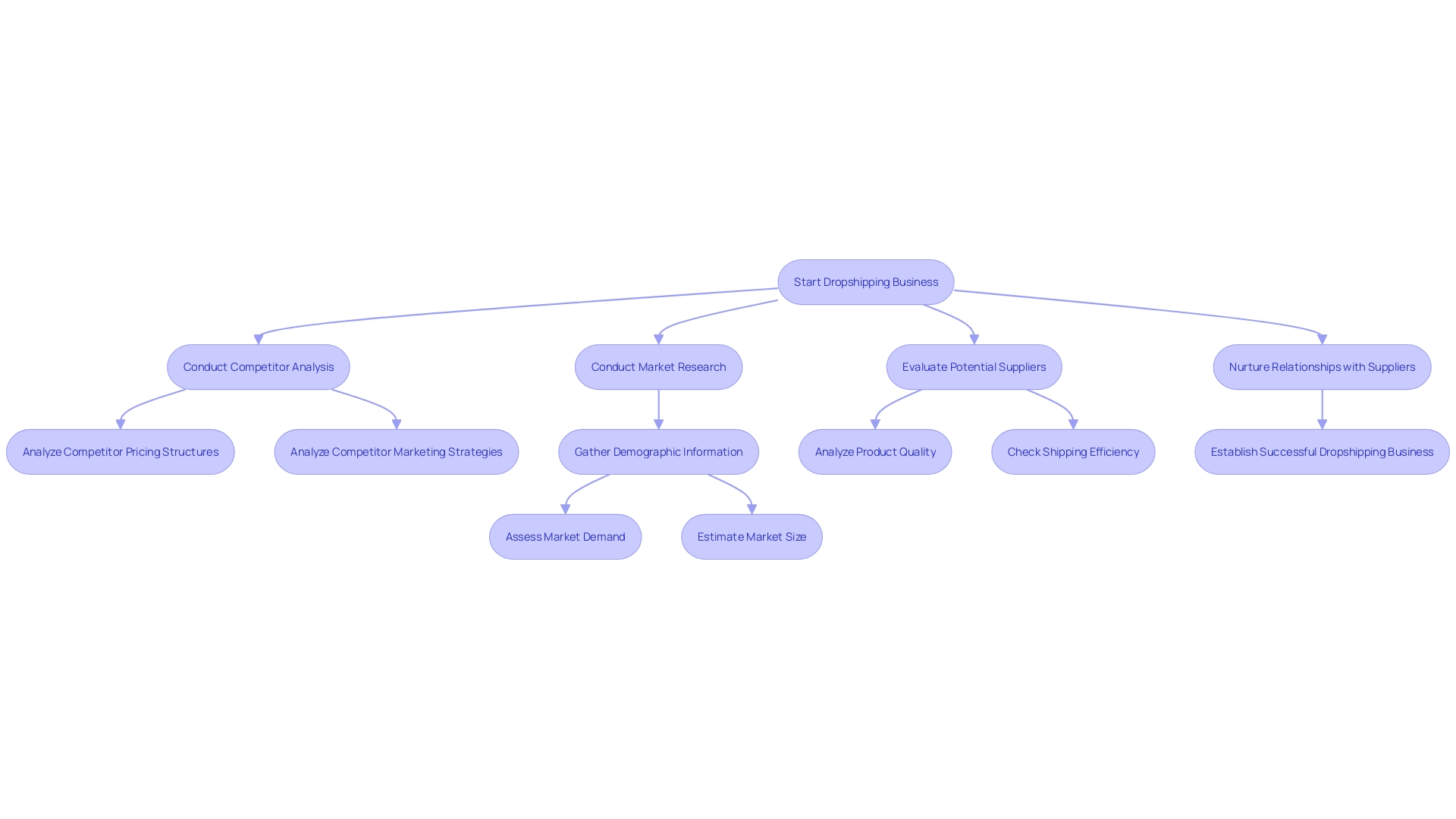
Selecting an eCommerce Platform
Choosing the ideal eCommerce platform is essential for launching a successful website. Key features to seek include a user-friendly interface, customizable templates, secure payment processing, and efficient inventory management. Renowned platforms like Shopify, WooCommerce, and Bigcommerce are preferred by many due to their proven track record in facilitating dropshipping ventures. These platforms provide the flexibility, scalability, and reliability required to adjust to your growing organizational requirements. Additionally, they have been known to support entrepreneurs during peak sales periods, such as the Amazon Great Indian Festival, where a well-structured website can handle increased traffic and sales volume. It's crucial to evaluate each platform's pricing and scalability to ensure it aligns with your long-term aspirations. By making an informed choice, you'll establish a strong groundwork for your e-commerce venture, positioning it for success in the competitive online market.
Designing Your Brand Identity
Carving out a distinctive brand identity is pivotal for businesses venturing into the online retail and dropshipping space. A compelling logo is more than just a graphic; it's a visual embodiment of your brand's principles, much like the emblematic typography of Forte Whey that conveys both vigor and modern style, or the swift, intuitive symbol that defines Rapid Technology's commitment to seamless transactions in FinTech. Your brand's color scheme and typeface should not only be eye-catching but also resonate with your brand's ethos, as seen in the strategic selection of neon, black, and beige for Forte Whey to evoke a sense of boldness and innovation.
A well-crafted website design is your virtual storefront, and its consistency and visual allure are paramount. It serves as a silent ambassador of your brand, akin to Milaq's logo, which reflects a promise of quality and innovation in the ride-hailing industry. Whether you engage a professional web designer or opt for sophisticated templates, the goal is to present a polished and unified brand experience that engenders trust and differentiates you from the competition.
As the retail landscape evolves, with innovative ventures like Walmart's The Cultureverse redefining brand experiences in the metaverse, and the surge in digital retail advertising to over $140 billion, the importance of a strong online presence is undeniable. In an era where a majority of retail dollars are still spent in physical stores, a robust and engaging online brand identity is your gateway to capturing a slice of the burgeoning eCommerce pie.
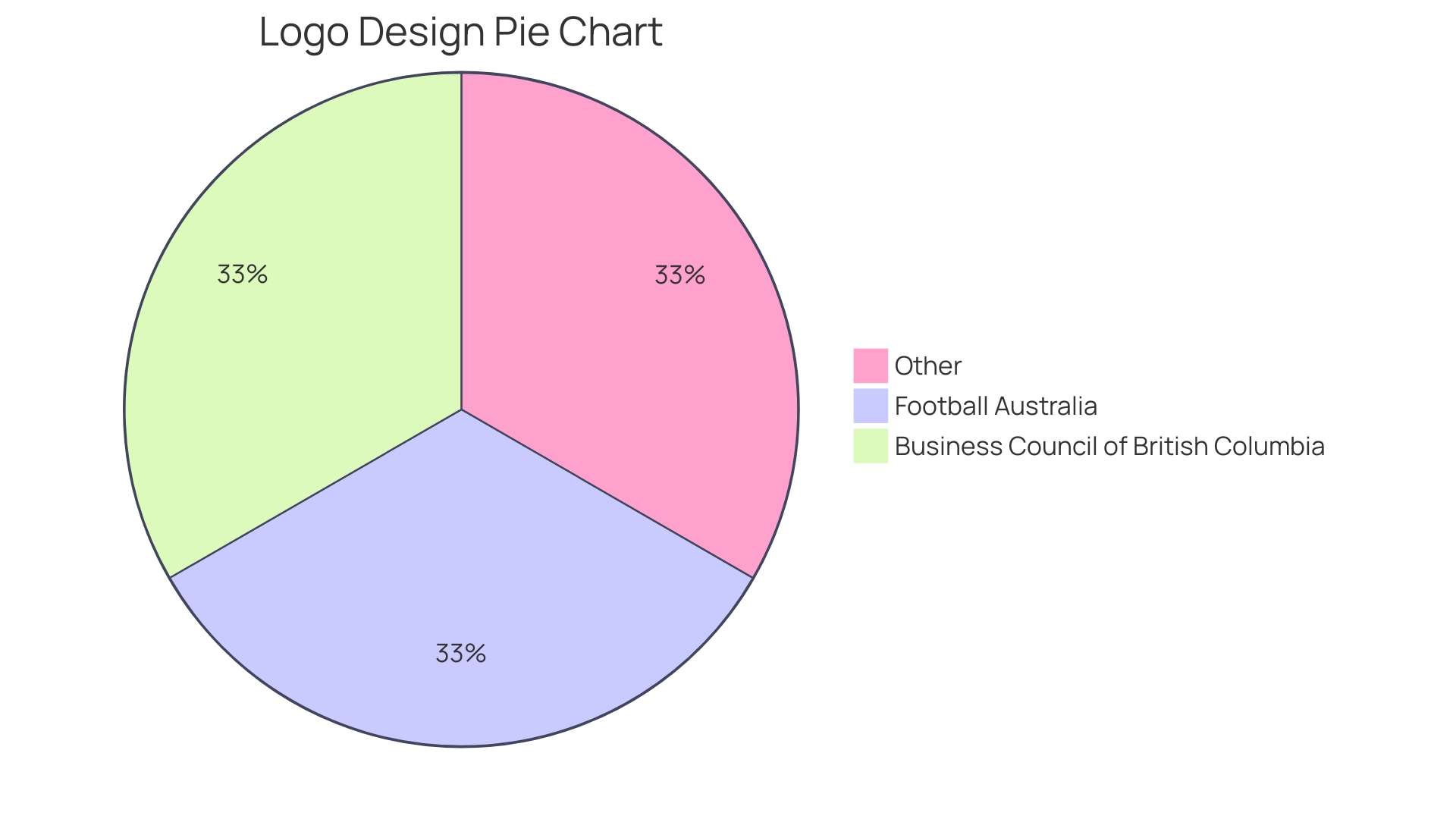
Building Your Online Store
Selecting the appropriate offerings and services, relying on market demand and a solid comprehension of the competitive landscape, is the foundation of any thriving e-commerce endeavor. With tools like Google Trends and social media analytics, you can pinpoint what consumers are seeking and how their preferences evolve, ensuring your offerings hit the mark.
Shopify emerges as a top contender for those looking to set up an online store without the hassle of coding. Its user-friendly drag-and-drop interface and customizable themes make it a go-to choice, especially since it provides the backend support, eliminating the need for separate web hosting or software installation.
However, creating an e-commerce site from scratch with technologies like Next.js or Vue.js entails a significant investment of time and money, with no guaranteed success. The intricacy of implementing tag, and category management, along with content filtering and offers handling, can amount to a staggering number of development hours.
The importance of an intuitive user experience cannot be overstated, particularly on mobile devices. With over half of the web traffic coming from mobile and a clear preference for well-functioning over aesthetically pleasing mobile sites, optimizing for mobile UX is non-negotiable. A mobile site that loads in two seconds or less can markedly increase conversion rates, and 79% of US consumers are more likely to share and return to a site that offers ease of use.
Incorporating a secure checkout process and transparent shipping and return policies further cements consumer trust. Maintaining your store's freshness through new products and promotions not only engages customers but also nurtures repeat clientele, which is crucial for sustaining growth in the competitive e-commerce marketplace.
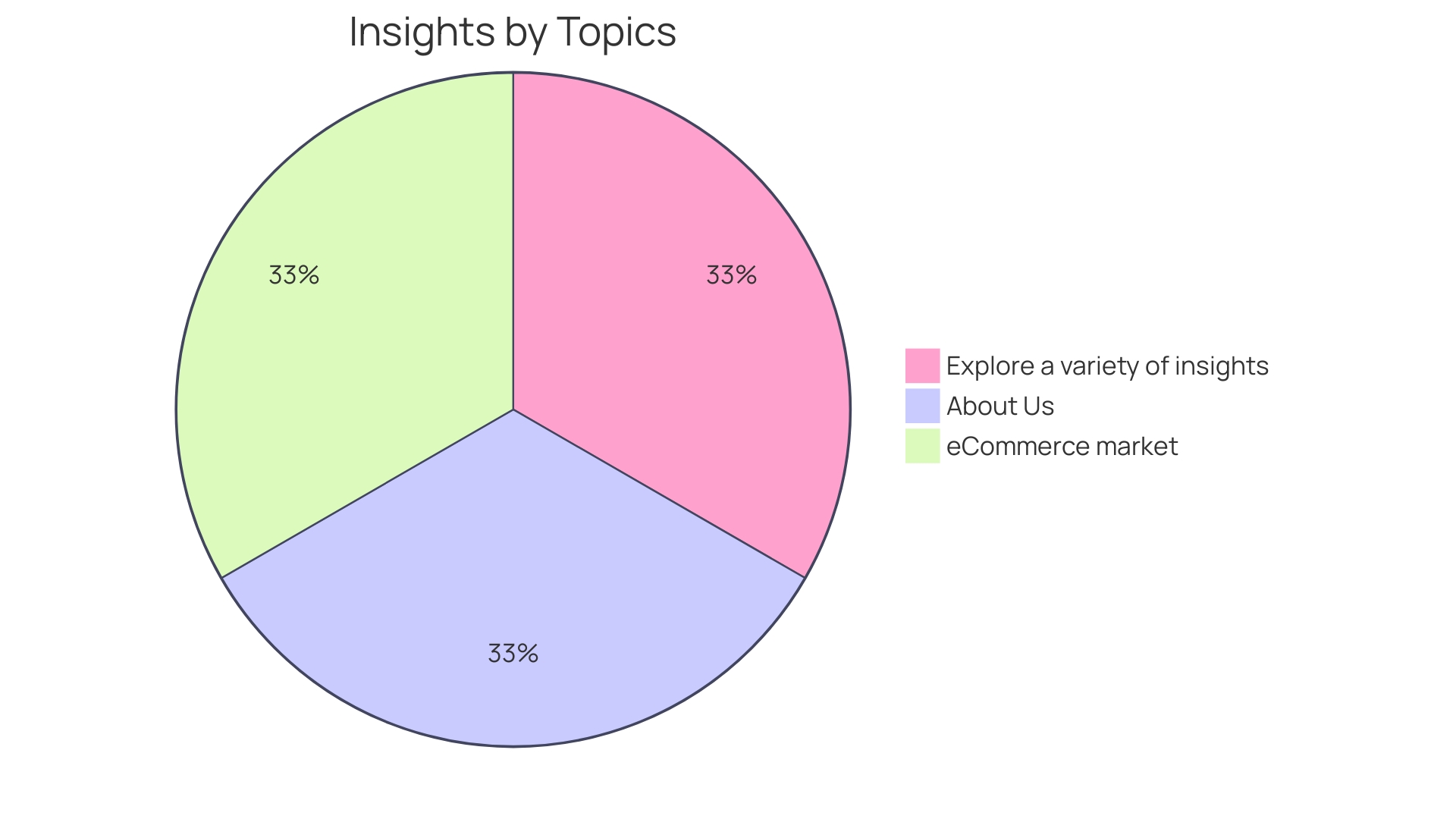
Registering Your Business and Setting Up Finances
Embarking on the journey of starting a dropshipping venture necessitates several foundational steps to ensure legal compliance and financial stability. At first, choosing a unique name for your enterprise and registering it with the appropriate authorities sets the stage for your brand to be recognized and legally protected. The arrangement of your enterprise, whether it is a sole proprietorship, partnership, or LLC, affects your liability and tax responsibilities; therefore, making this decision early on is crucial.
Fulfilling legal requirements includes obtaining necessary licenses or permits, particularly for an online retail environment. This step safeguards against operational hiccups and aligns with the practices of successful entrepreneurs who have carved out niches within competitive markets, such as Gothrider Coffee. Their approach to developing a distinct brand rather than simply running an online store emphasizes the significance of establishing a robust foundation.
In addition, establishing a distinct bank account is not only a formal necessity; it acts as the foundation for managing your financial operations. An efficient accounting system is crucial, providing a transparent overview of costs, sales volume, and other financial metrics in one place. This not only simplifies tracking your finances but also enhances decision-making, drawing parallels with the streamlined dashboards used by platforms like SaleHoo.
Lastly, tax compliance is non-negotiable. It's prudent to consult with a tax professional to navigate the complexities of e-commerce taxation. As India's e-commerce market flourishes, underscored by events like Amazon's Great Indian Festival and the success stories emerging from Flipkart's platform, the rigor of setting up your business correctly becomes evidently crucial in establishing a strong foothold in the vibrant world of online retail.
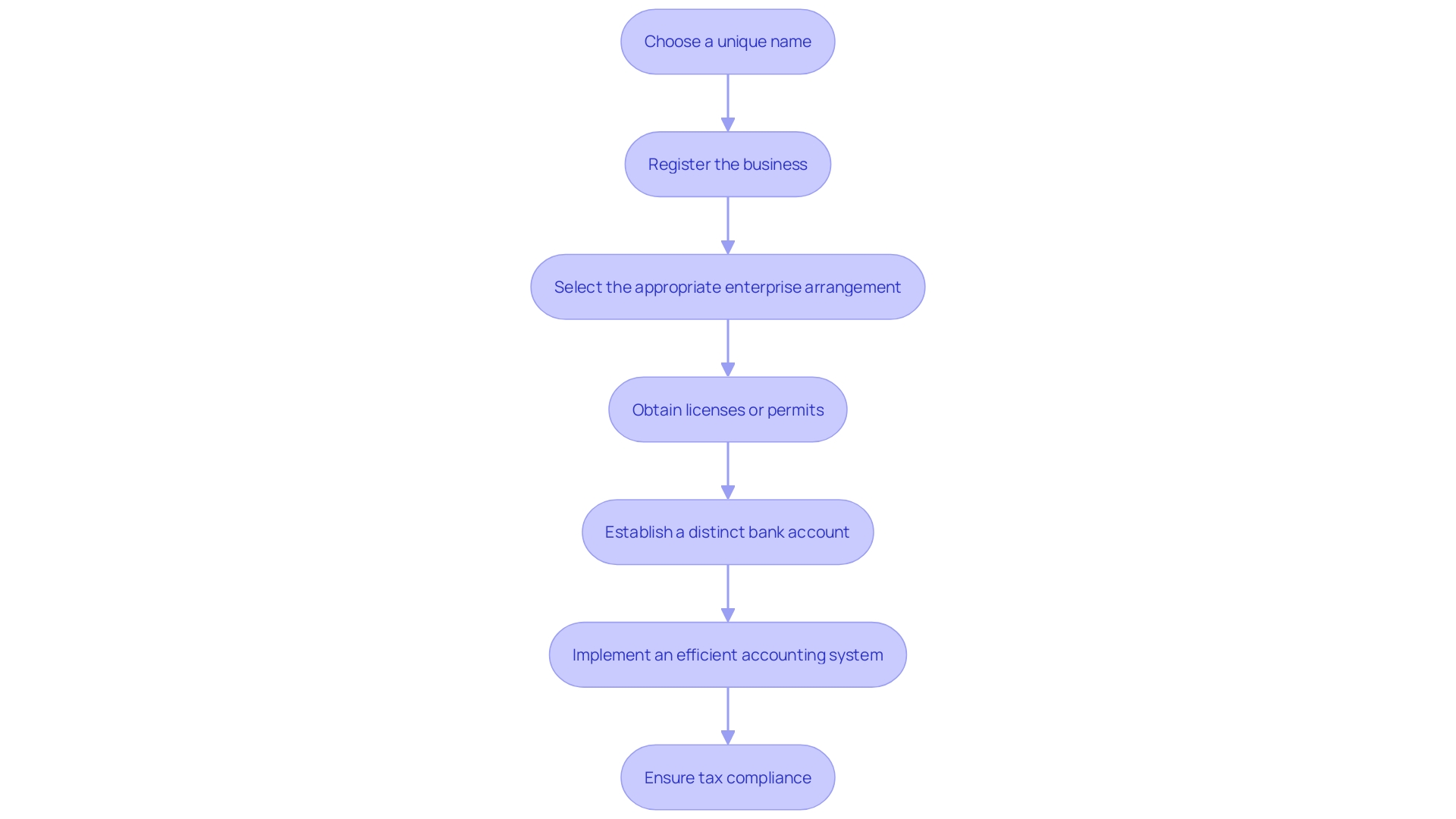
Adding Products and Setting Prices
Creating a prosperous dropshipping website entails more than merely cataloging items; it necessitates a strategic method to selecting and pricing the merchandise. To start, it's crucial to explore the market and identify popular items that are in line with your niche. Offering a diverse array of high-quality items will cater to the varied preferences of your customer base. When it comes to pricing, profit margins and shipping costs must be carefully weighed to devise a pricing strategy that ensures both competitiveness and profitability.
Exploring various price points can help in identifying the sweet spot that attracts customers while also enhancing revenue. It's important to keep a pulse on market trends and consumer behavior, adjusting your product offerings accordingly to maintain relevance and appeal in the dynamic e-commerce landscape.
For instance, the recent rise of checkout-free stores, such as the innovative Zippin technology-based store in Dublin Airport, underscores the importance of staying ahead of retail trends. Such advancements emphasize the continuous development of retail systems and the necessity for businesses that utilize direct-to-consumer shipping to consistently adjust their approaches.
Furthermore, the selection of suppliers is a crucial element that can influence the outcome of your ecommerce endeavor. It's vital to collaborate with suppliers who not only offer an extensive range of items but also maintain the utmost levels of quality, guaranteeing customer satisfaction and repeat patronage.
In summary, the secret to a successful e-commerce business lies in thorough research, strategic pricing, and a flexible approach to product selection, all while maintaining strong supplier relationships for a smooth retail experience.
Testing Your Website
To guarantee a smooth release for your dropshipping online presence, thorough testing is a crucial measure not to be neglected. Start by scrutinizing every aspect of the site's functionality, from links and buttons to submission forms, to guarantee they operate flawlessly. Give highest importance to the performance of the webpage, aiming for fast loading times by implementing optimization techniques if required.
Embrace diversity in testing by evaluating the online platform across various browsers and devices to affirm its universal compatibility. Enlist the help of peers to navigate the online platform, soliciting their honest feedback for an outsider's perspective on the user experience. Address any identified issues promptly, refining the user interface and functionality to perfection before the site goes live.
Consider examples such as Le Parisien's homepage transformation, which was motivated by internal expansion and the necessity to accommodate a multilingual audience, highlighting the significance of a well-organized, user-friendly online platform that can adjust to growth and change.
Stay informed with the latest developments, such as Google's updates to site names in search results, to ensure that your online presence is accurately represented across all platforms. Additionally, make sure to conduct special functionality checks, like placing orders and performing searches, to confirm operational integrity across the board.
By meticulously adhering to these testing protocols, you'll set the stage for a successful launch, providing a robust and reliable online shopping experience for your customers from day one.
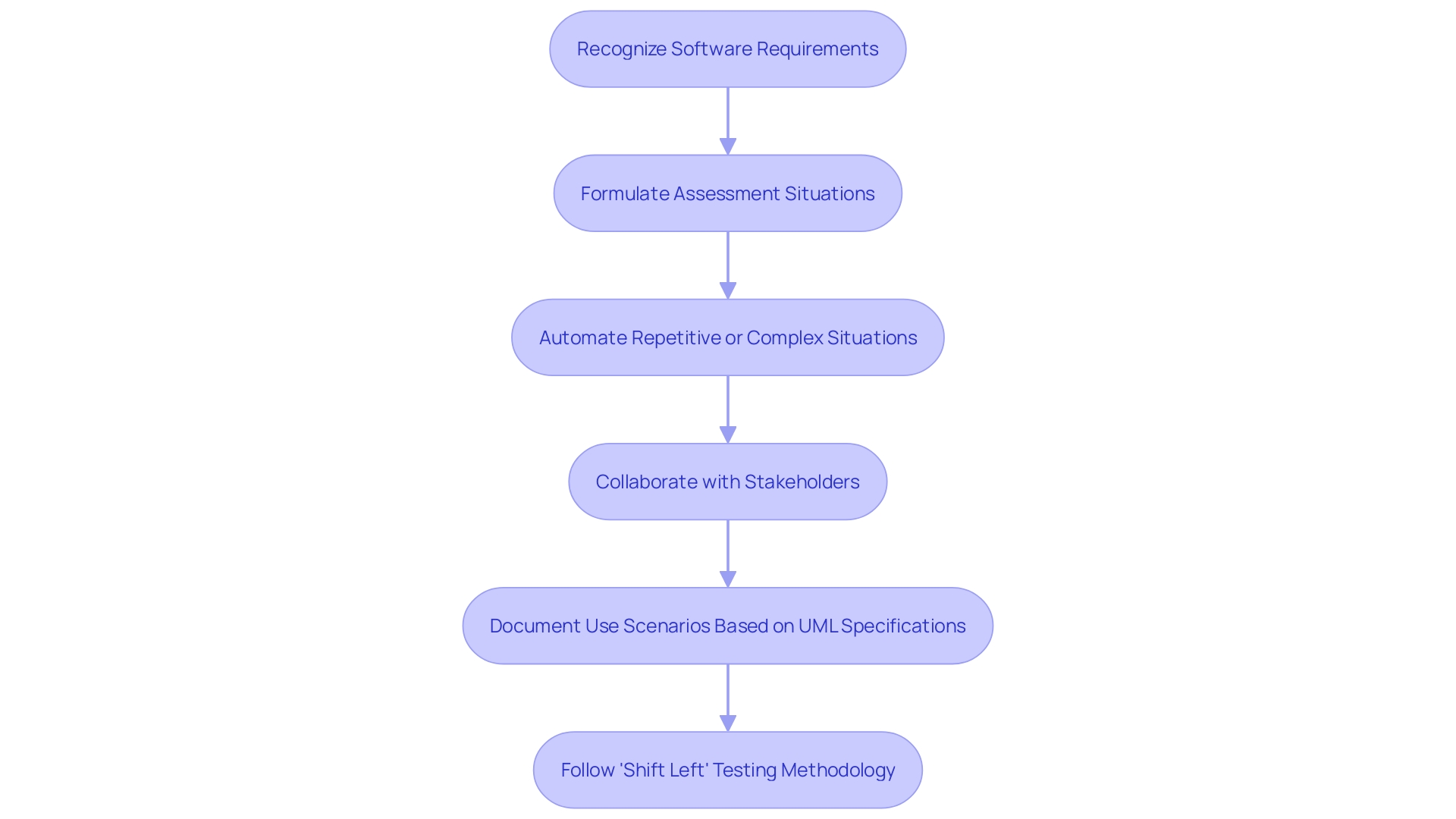
Launching Your Dropshipping Website
Launching a dropshipping platform is a pivotal moment for any ecommerce entrepreneur. Before your site goes live, meticulously confirm the accuracy of product descriptions, pricing, and shipping details. It's essential that your payment gateway is thoroughly tested and error-free. Crafting a strategic marketing plan is crucial to attract visitors to your new online presence. Consider a vibrant social media campaign, engaging with influencers, and employing targeted advertisements to captivate your audience from the outset.
Monitoring your website's performance in real-time is key. This allows you to swiftly adapt to customer feedback and evolving market trends, akin to the way Gothrider Coffee established its unique brand presence in the market. Remember, the success of your launch is heavily dependent on how well you respond to and implement customer insights and adapt to the competitive landscape.
Just as Phil Kyprianou utilized his digital marketing skills and passion for ecommerce to establish a distinct brand, it's crucial for you to utilize your unique strengths and market knowledge to make your dropshipping venture flourish. Imitate the approaches that have guided prosperous brands, like the transparent, single-click merchandise import system and comprehensive merchandise tracking used by SaleHoo Dropship, to maintain your operations streamlined and customer-focused.
Dropshipping, after all, offers a unique business model by allowing retailers to sell products directly to customers without maintaining stock, as the item is shipped from a third party. By understanding this model and its benefits, you can navigate the ecommerce landscape with agility, much like the largest dropshippers in the industry. With the correct strategy, your ecommerce endeavor can not only start successfully but also keep evolving and adjusting in the constantly changing world of online business.
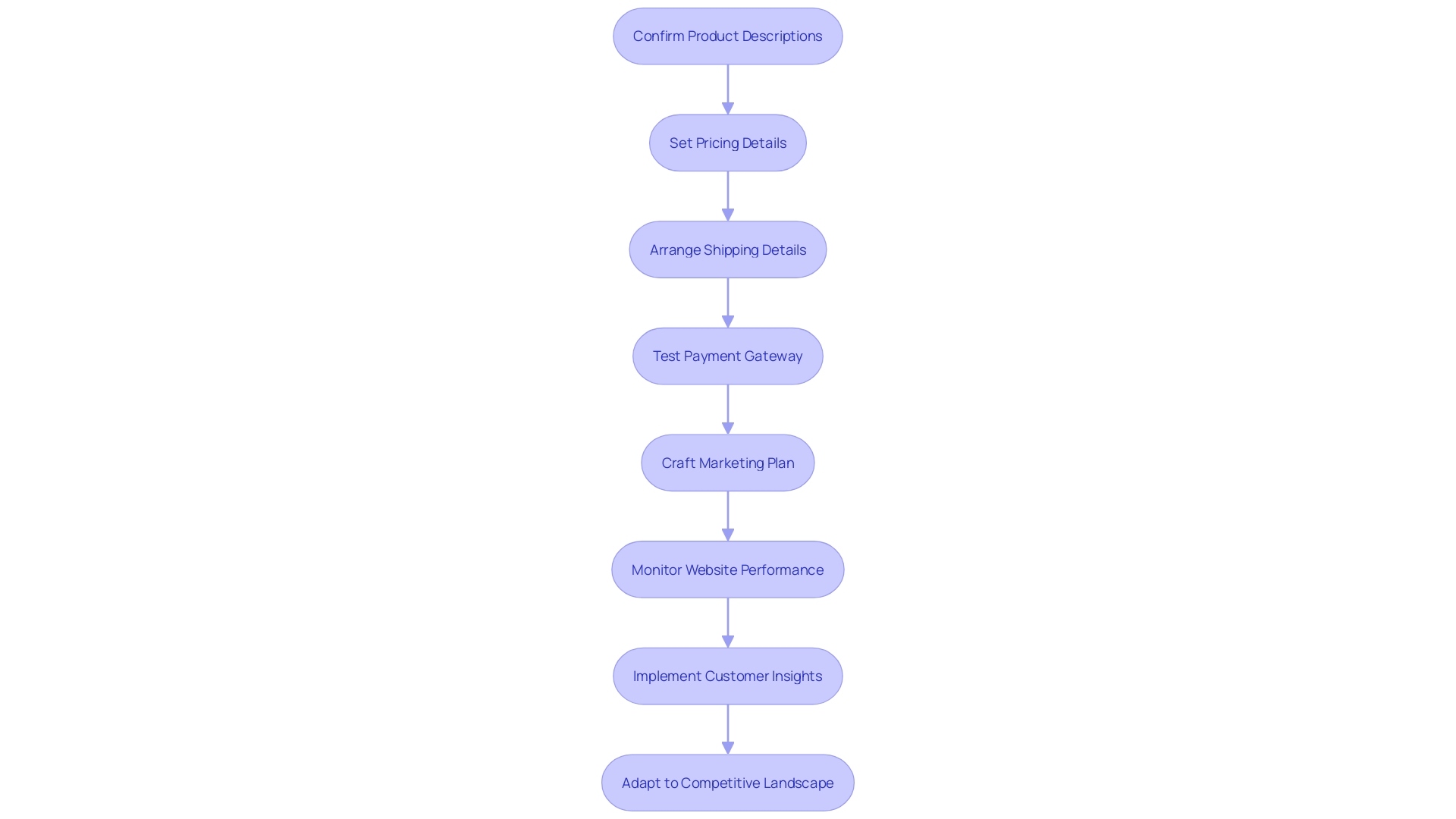
Marketing Your Dropshipping Business
Crafting a robust digital marketing strategy is pivotal for the prosperity of your dropshipping venture. It's essential to amplify your online presence to captivate potential consumers. Apply search engine optimization (SEO) tactics to ascend your website's ranking in search results, making it more visible to those seeking your offerings. Social media platforms are fertile ground for connecting with your audience and showcasing your offerings, enhancing brand engagement. Consider launching pay-per-click (PPC) advertising initiatives to funnel targeted traffic directly to your site. Email marketing is a potent tool for cultivating leads and fostering customer loyalty, encouraging them to return for future purchases. It's imperative to continuously scrutinize the effectiveness of your marketing endeavors, refining your tactics based on concrete performance data to ensure the highest return on investment.
Optimizing for Conversion
To truly enhance your dropshipping business's online presence and sales, it's essential to master the art of conversion rate optimization. Begin by making sure that your online platform is user-friendly, with a neat and simple layout that enables customers to easily search and find items. Craft product pages that capture attention with engaging descriptions, crisp images, and persuasive customer testimonials. Streamline your checkout process, offering a variety of payment methods to accommodate customer preferences.
Incentivize purchases by providing appealing offers such as discounts, complimentary shipping, or time-sensitive deals, all of which can significantly boost conversion rates. It's vital to understand that a high conversion rate hinges on more than just visitor numbers; it reflects the percentage of visitors who take a desired action on your site. For example, if you have 100 conversions from 5,000 visitors, you're looking at a conversion rate of 2%.
This metric is your compass for measuring the effectiveness of your online presence and marketing efforts. Remember, however, that accuracy is key when calculating conversion rates. To avoid miscalculations, compare equivalent data sets and focus on specific actions or pages when analyzing these rates. Track and analyze conversion data rigorously, using sophisticated tools and dashboards to discern patterns, identify opportunities, and inform your strategic decisions.
By embracing a comprehensive approach to conversion rate optimization, you'll be able to fine-tune and enhance your site's performance, converting traffic into sales without the need to inflate your marketing budget. This strategic finesse can elevate your role from a marketer seeking additional ad spend to a shrewd digital strategist capable of extracting greater ROI with less expenditure.
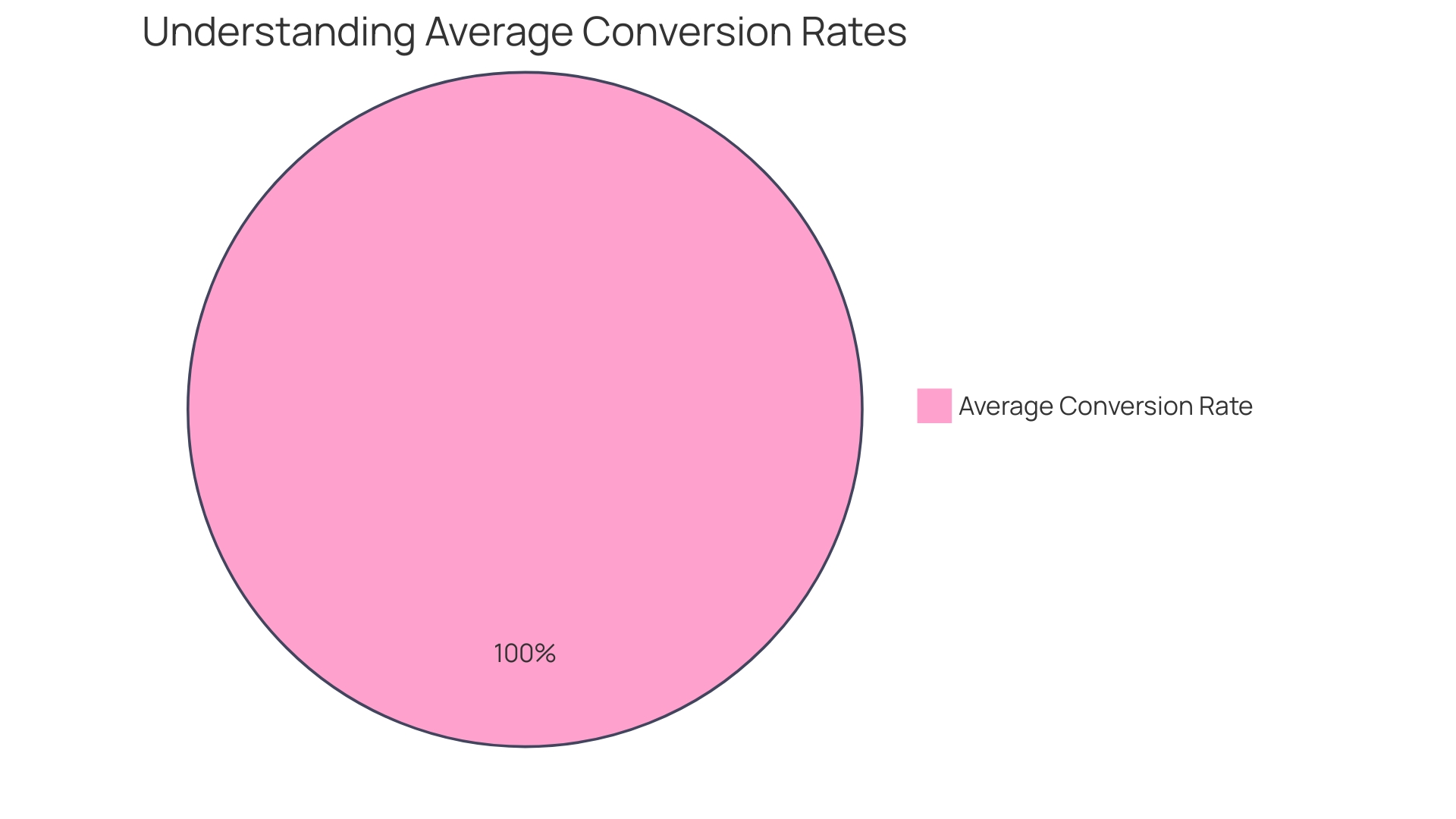
Monitoring Performance and Reinvesting Profits
Monitoring the health and performance of your online retail business is crucial once your dropshipping website is operational. It's essential to keep track of key performance indicators (KPIs) such as site traffic, conversion rates, and average order value, which reflect the vitality of your e-commerce venture. This data can point out areas that need refinement or suggest new strategies to adopt.
For instance, Phil Kyprianou, the founder of Gothrider Coffee, transitioned from digital marketing in the events industry to establishing a unique brand in the competitive coffee market. He utilized his experience in e-commerce and found a market for Gothrider by offering a uniquely edgy and rebellious line. His approach exemplifies the importance of understanding consumer preferences and the value of brand differentiation. By analyzing market trends and customer feedback, Phil successfully introduced bundling to enhance the customer experience and brand value.
Reinvesting profits is another vital aspect for growth. Investing funds strategically in marketing, website optimization, and expanding your product range can propel your enterprise forward. As the e-commerce industry evolves, staying abreast of technological advancements and market shifts is imperative to maintain a competitive edge.
According to Shopify's insights, the e-commerce sector is brimming with potential but also fraught with challenges, such as the need for innovation, data security, and adapting to economic conditions. An establishment like Gothrider Coffee, which has carved out its niche, must navigate these challenges while focusing on growth and customer satisfaction.
In summary, the journey of a dropshipping business is one of constant evolution and adaptation. By meticulously analyzing KPIs, reinvesting profits wisely, and staying in tune with industry trends and customer needs, one can navigate the competitive landscape and steer their e-commerce venture towards success.
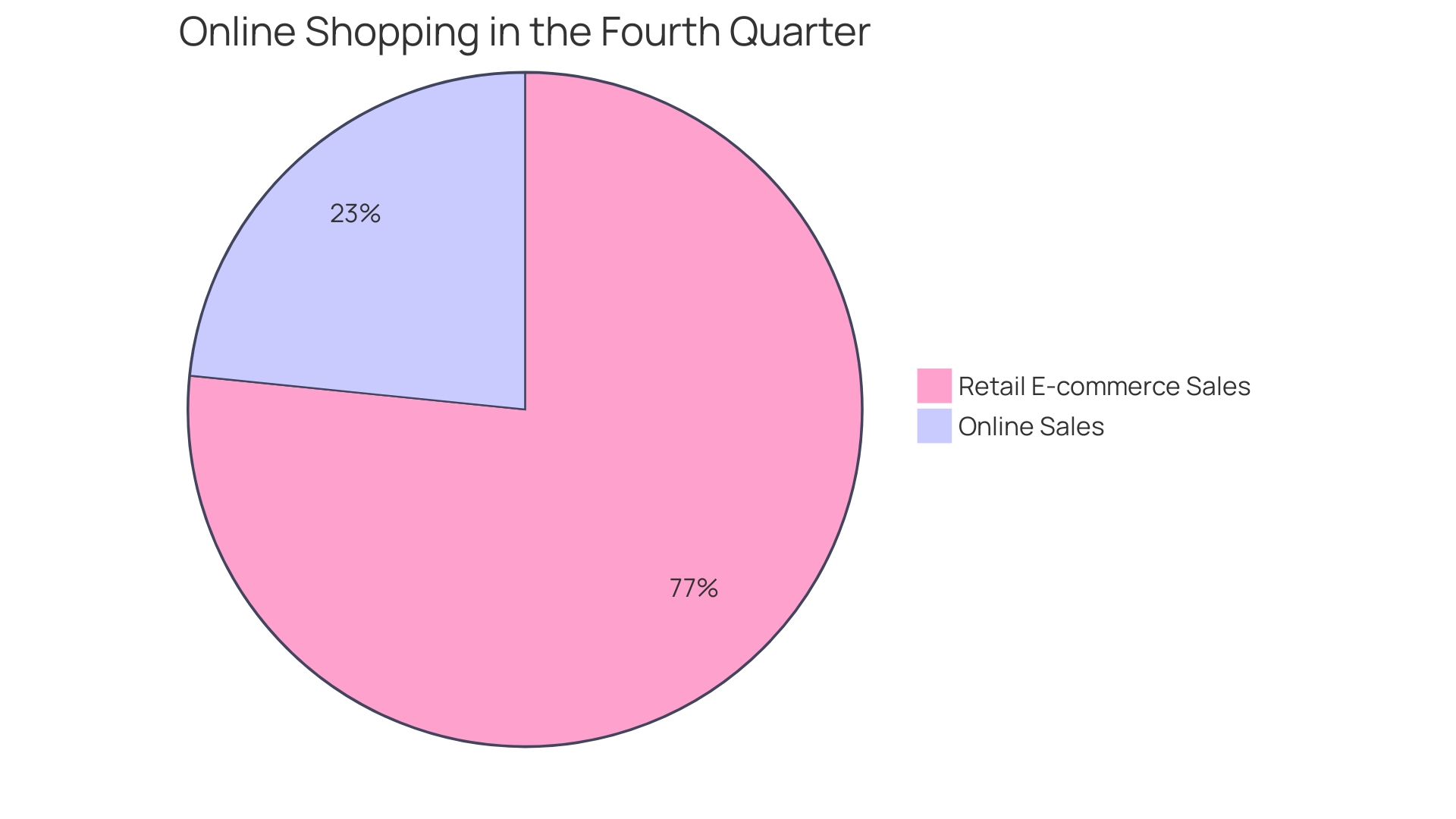
Conclusion
Choosing the right niche is crucial for the success of your dropshipping business. Aligning your product selection with your interests, passions, or expertise ensures engagement and authenticity, giving you a competitive edge. Thorough market research, utilizing tools like Google Keyword Planner, helps identify profitable niches with high demand and low competition.
Additionally, analyzing existing products in your potential niche and staying up-to-date with retail innovations will aid in differentiating your brand.
Selecting the optimal eCommerce platform, designing a distinctive brand identity, and building a user-friendly online store are essential steps for launching a successful dropshipping website. Registering your business, setting up finances, and establishing reliable supplier relationships ensure legal compliance and financial stability. Adding carefully selected products and setting competitive prices, along with comprehensive testing of your website, are crucial for a seamless launch.
Marketing your dropshipping business, optimizing for conversion, and monitoring performance to reinvest profits are key strategies for sustained growth and success in the dynamic e-commerce landscape. Embracing innovation and customer-centric approaches will position your dropshipping venture for long-term prosperity.
In conclusion, by following these steps and embracing a strategic approach, you can establish yourself as an industry expert in the dropshipping space. Positioning your brand as one that offers authoritative advice and recommendations will not only attract customers but also set you apart from competitors. Remember to continuously adapt and innovate to thrive in the ever-changing world of e-commerce.





